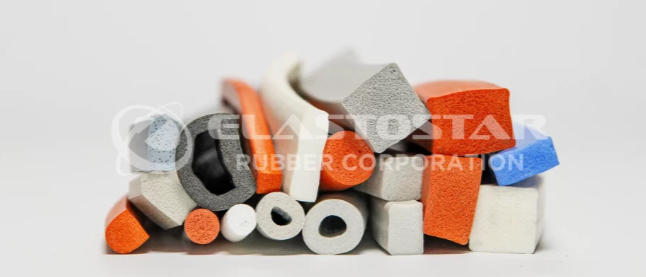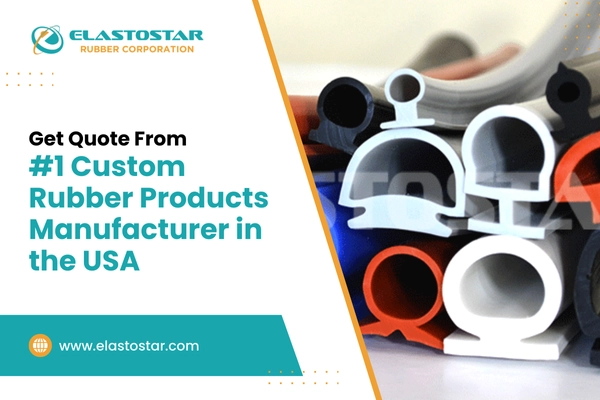The aerospace industry demands components that can perform flawlessly in the harshest environments where temperature extremes, high altitudes, and constant vibration are the norm. Among these critical components, silicone seals excel for their durability, flexibility, and resistance to extreme conditions.
Aerospace sealing solutions are essential in maintaining safety and efficiency in jet engines and satellite systems. As aerospace sealing solutions evolve, so does the need for innovation and reliability. Elastostar Rubber Corporation meets this challenge with advanced silicone sealing technologies designed to perform in the sky, in orbit, and beyond.
In this blog, we will explore how silicone seals transform aerospace innovation, one application at a time.
What Are Silicone Seals and Why Are They Critical in Aerospace?

Silicone seals are precision-engineered components used to prevent the leakage of air, fluids, and gases in high-performance environments. Their ability to maintain flexibility and function under extreme temperatures, pressure changes, and vibration makes them ideal for the aerospace seals required in aircraft and spacecraft systems. Their role is essential in supporting safe and efficient operation, from jet propulsion to cockpit insulation.
These seals are typically made from high-performance aerospace rubber, offering excellent heat, UV, and chemical exposure resistance. As a result, aviation seals have become a standard choice across the aerospace sector for commercial and defense applications.
Read More– Top Applications of Silicone Rubber in the Aerospace Industry.
How Silicone Seals Address Critical Challenges in Aerospace Environments
Modern aircraft face intense operational demands, so components like aircraft sealing, aerodynamic seals, and airplane seal systems are crucial from takeoff to landing. These seals must tolerate high speeds, pressure fluctuations, and rapid temperature changes without failure.
Due to their flexibility, thermal resistance, and long-term durability, silicone seal gaskets are uniquely suited for aerospace use. They perform reliably in cabin and engine environments; systems remain sealed against vibration, weather, and extreme altitude conditions that push materials to their limits.
Core Applications of Silicone Seals in Aerospace Systems

Sponge Silicone seals play a vital role across nearly every subsystem in modern aerospace design. From cabin pressure maintenance to shielding sensitive electronics, their applications are as diverse as they are critical.
- Cabin & Door Seals
Components like door sealing rubber and aircraft door seals in aerospace interiors help maintain cabin pressure, block external noise, and keep out environmental elements. These seals must remain flexible over thousands of open-close cycles while enduring fluctuating cabin conditions.
- Window and Windshield Gaskets
Clear visibility and safety are vital, making window sealing rubber for pressurized windows and cockpit windshields. These seals provide a tight barrier against temperature swings, moisture, and UV exposure at high altitudes.
- Engine & Exhaust Systems
Silicone rubber seals designed with engine gasket material and aircraft gasket specifications must endure extreme heat, pressure, and exposure to fuel and oil. These gaskets protect high-performance engine components while maintaining airtight sealing during all flight phases.
- Avionics & Electrical Component Protection
Protecting onboard electronics is mission-critical, and aviation o rings along with gasket seal rubber play a key role in shielding sensitive systems from moisture, dust, and EMI interference. These seals ensure reliability in avionics, sensors, and control system
- Satellite and Spacecraft Systems
Advanced applications such as satellites and orbital vehicles depend on reliable sealing under vacuum and radiation. Seal aircraft systems and aerospace sealing solutions must meet the highest performance standards in zero-gravity and extreme temperature environments.
Silicone Seals vs Other Elastomers in Aerospace
Choosing the ideal aerospace seal involves understanding how elastomers perform in extreme environments.
While materials like EPDM, Neoprene, and Fluorosilicone are also used, silicone gaskets are often preferred due to their versatility and high-temperature stability.
| Property / Material | Silicone | Fluorosilicone | EPDM | Neoprene |
| Temperature Range | -100°C to 300°C | -70°C to 230°C | -50°C to 150°C | -40°C to 120°C |
| UV & Ozone Resistance | Excellent | Excellent | Good | Moderate |
| Chemical Resistance | Good | Excellent (especially fuels & oils) | Moderate | Moderate |
| Flexibility at Low Temp | Excellent | Very Good | Good | Fair |
| Cost | Moderate | High | Low | Low |
| Aerospace Compliance | Excellent | Excellent | Limited | Limited |
Silicone tubes offer a strong combination of thermal stability, flexibility, and environmental resistance for most aerospace applications where performance under pressure is critical.
Why Is Precision So Important in Custom Silicone Seal Manufacturing?
Even the smallest dimensional error can lead to performance failure in aerospace engineering. That’s why components like rubber extrusion profiles are manufactured with extreme precision to meet tight tolerances and exact specifications.
Custom silicone seals are often tailored through extrusion, compression molding, or injection molding, each suited for specific part geometries and performance needs. These seals can be engineered to unique shapes, cross-sections, or hardness levels depending on their end-use, whether in door frames, electronics enclosures, or propulsion systems. High precision isn’t a luxury in aerospace; it’s necessary for safety and success.
What Certifications and Standards Do Aerospace Seals Need to Meet?
Compliance with regulatory standards is essential for aircraft seals to ensure safety and system integrity. Reputable aerospace seal manufacturers must meet stringent material and quality benchmarks before a seal is approved for flight.
The most critical standards are FAR 25.853 (flammability for aircraft interiors), UL94 V-0 (flame resistance), NASA low-outgassing requirements, and AS9100D for aerospace quality management. Elastostar’s silicone materials also meet USP Class VI guidelines and pass Section 88 and 87, proving their biocompatibility and safety in the most demanding aerospace and high-purity UL 94 flame retardant silicone sponge environments.
What Are the Latest Innovations in Silicone Seal Technology for Aerospace?
As aerospace platforms advance, so do the materials designed to support them. Today’s aerospace aerodynamic seals go far beyond traditional sealing engineered for smarter performance and reliability. The silicone rubber gasket has evolved into a multifunctional solution with high adaptability.
Recent innovations include smart seals embedded with sensors for real-time diagnostics, dual-durometer profiles that balance flexibility and strength, and coatings that resist chemicals, friction, and high heat. These technologies are now being integrated into aircraft systems to improve performance, reduce maintenance intervals, and increase mission safety.
How Are We Driving Innovation in Aerospace Sealing?
As a trusted silicone rubber gasket manufacturer, Elastostar Rubber Corporation is vital in delivering high-performance sealing solutions to aerospace companies worldwide. From rapid prototyping to full-scale production runs, we provide end-to-end support for mission-critical environments.
Our engineering team works closely with clients to offer design assistance, reverse engineering services, and custom compound development. Every gasket we produce meets strict aerospace compliance standards while offering unmatched reliability. With one of the shortest lead times in the industry and a commitment to precision, we help push the boundaries of innovation on the ground, in the air, and beyond.
Have an aerospace sealing challenge? Contact us today to connect with our team and explore your custom solution.
Recommended Reads
- Top 5 Uses of Silicone Rubber Seals in the Aerospace Industry
- The Importance of Silicone Rubber in the Aerospace Industry
- Top Applications of Silicone Rubber in the Aerospace Industry
Conclusion
Silicone sponge seals are vital in today’s aircraft and spacecraft performance, safety, and innovation. Their ability to handle extreme environments makes them a critical component in the evolving aerospace industry. These seals contribute to mission success at every level, from cabin insulation to engine protection and even silicone tubing for fluid and air transfer systems.
As technology advances, so will the demand for smarter, more efficient aerospace sealing solutions. With trusted manufacturers like Elastostar leading the way in precision and quality, the future of aerospace is sealed—secure, sustainable, and ready to reach new heights.
FAQs
Why is silicone used for seals in aerospace?
Silicone is used for aerospace seals because it can handle extreme temperatures, pressure variations, and environmental exposure. It remains flexible, durable, and reliable in high-altitude and engine-level conditions.
What are the applications of silicone rubber in aerospace?
Silicone rubber is used throughout aircraft and space systems, including door and window seals, engine gaskets, avionics enclosures, electrical insulation, and vibration-dampening components.At Elastostar, we provide custom-molded and extruded silicone rubber products built for these exact applications.
Is silicone used in space applications?
Yes, silicone gasket is commonly used in space applications. Its low outgassing, thermal stability, and radiation resistance make it ideal for use in spacecraft seals, satellite systems, and onboard equipment. Our aerospace-grade materials at Elastostar meet critical space compliance standards for sealing performance.
How does a silicone seal work?
A silicone seal forms a flexible yet tight barrier between surfaces, preventing air, fluids, or contaminants from escaping or entering. It adapts to movement, pressure, and temperature without losing its sealing integrity.
What are the properties of silicone seals that make them aerospace-ready?
Silicone sponge seals offer high heat, chemical, and UV resistance, flexibility over a wide temperature range, and long-term durability for aerospace environments and for precision-made aerospace seals. Contact us to learn how Elastostar can support your project.
What is silicone used for in aerospace engineering?
In aerospace engineering, silicone is used in critical sealing applications, thermal insulation, EMI shielding, and protective coatings. As experienced rubber extrusion manufacturers, we offer engineered profiles to meet the toughest aerospace requirements.


